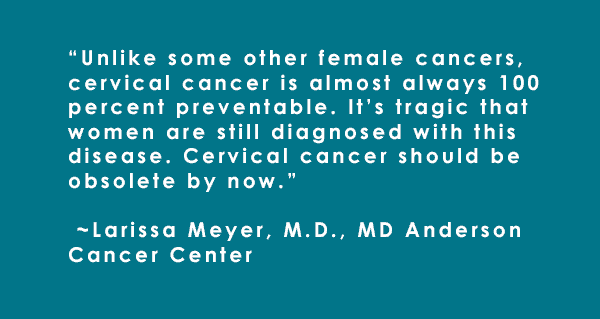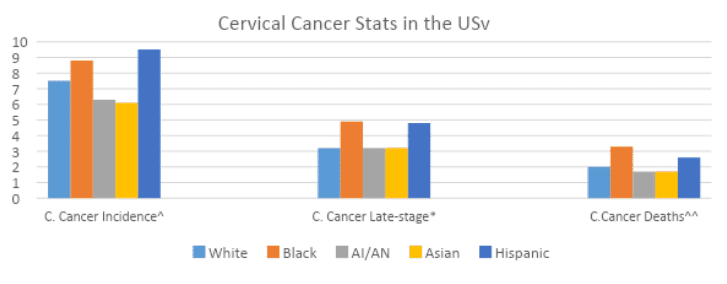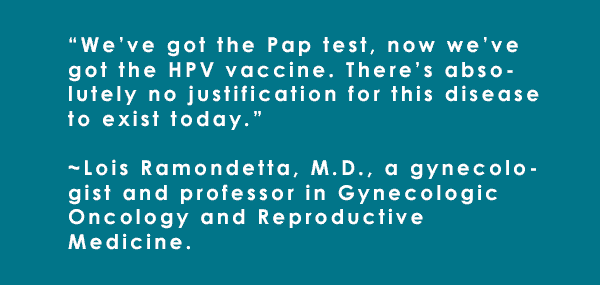Why is Cervical Cancer Still Claiming Lives?
January 14th, 2021 | viewpoint

Eighty years after the development of the Pap smear and 15 years after the introduction of the human papillomavirus vaccine, women, particularly women of color, are still dying from the disease.
In the United States, Hispanic women are most likely to get cervical cancer, followed by African-Americans, American Indians and Alaskan natives, and whites. Asians and Pacific Islanders have the lowest risk of cervical cancer in this country. (1) Hispanic/Latina and Black/African-American women have higher rates of cervical cancer than women of other racial/ethnic groups, with Black/African-American women having the highest rates of death from the disease.
 ^Incidence: age-adjusted rate/100,000 women. 2013-2017
^Incidence: age-adjusted rate/100,000 women. 2013-2017
*Late-stage incidence: age-adjusted rate/100,000. 2013-2017
^^Deaths: age-adjusted rate/100,000. 2014-2018
These statistics are important to monitor as they also measure access to care:
Cancer disparities reflect the interplay of many factors, including social determinants of health, behavior, biology, and genetics—all of which can have profound effects on health, including cancer risk and outcomes. (3)

In the U.S., women of color experience cancer disparities because they are more likely to encounter obstacles to health care services. For example, people with low incomes, low health literacy, long travel distances to screening sites, or those who lack health insurance, transportation to a medical facility, or paid medical leave are less likely to have recommended cancer screening tests and be treated according to guidelines than those who don’t encounter these obstacles. In addition to racial and ethnic disparities in cervical cancer rates, research suggests that LGBTQ individuals face health disparities linked to social stigma, discrimination, and denial of civil and human rights, placing them at higher risk for cervical cancer and late-stage diagnosis. (4)
The following factors are associated with inequities in cervical cancer outcomes: comorbidities, insurance status and access to care, socioeconomics, care experiences, and environmental factors. These fall into three categories:
Our work with the Wyoming Breast and Cervical Cancer Screening Program evaluated the impact of the early detection program and identified several key strategies that could improve cervical cancer rates and outcomes.
By focusing on understanding structural factors that in turn affect the range of social determinants of health, and how they together affect health, this evaluation will illustrate the problem while clarifying strategies needed to advance cervical cancer health services. Because many factors can influence cancer disparities, addressing them is not always simple or straightforward. Reducing or eliminating some cancer disparities in the pursuit of health equity will require policy and systems changes to overcome systemic social, racial, and institutional inequalities.
Systems frameworks show how the multi-dimensional and dynamic health care system can facilitate or impede population health improvements. For most, the lasting impression of the health care system begins at the micro-level, where providers and patients interact.
Micro-level strategies: Strengthen connections for screening and care through system facilitators such as culturally competent patient navigators and peer support/educators to improve service delivery. Title X clinics are for many the entry point into the medical care system and a key source of cervical cancer prevention and screening: 6 of 10 women who visit Title X clinics consider them a primary source of health care.
Mid-level strategies: Create avenues for social support and community connection. Evaluation data indicate that social support and connection can be key facilitators for breast and cervical cancer screening and treatment. A strong and well-connected network can be a protective factor for many women, and may be particularly relevant for those without insurance and/or access to high-quality health care.
Macro-level strategies: Analyze current health care insurance policies to ensure equitable access to services. Patient and household out-of-pocket costs for health care services and the percentage of people and households covered by health insurance are key indicators of this macro-level strategy. (5) Research suggests that states with expanded Medicaid eligibility have improved reproductive health outcomes, including cancer screening rates, compared to states that do not, and that early adoption of Medicaid expansion is associated with greater improvements in preventive care, such as breast and cervical cancer screening.
Coordination across stakeholders with affected communities is foundational to overcoming the economic, structural, and social barriers listed above.
Written by: Yvonne Hamby, Ilana Webb, Lea Ayers LaFave, Panos Smyrnios
We strive to build lasting relationships to produce better health outcomes for all.